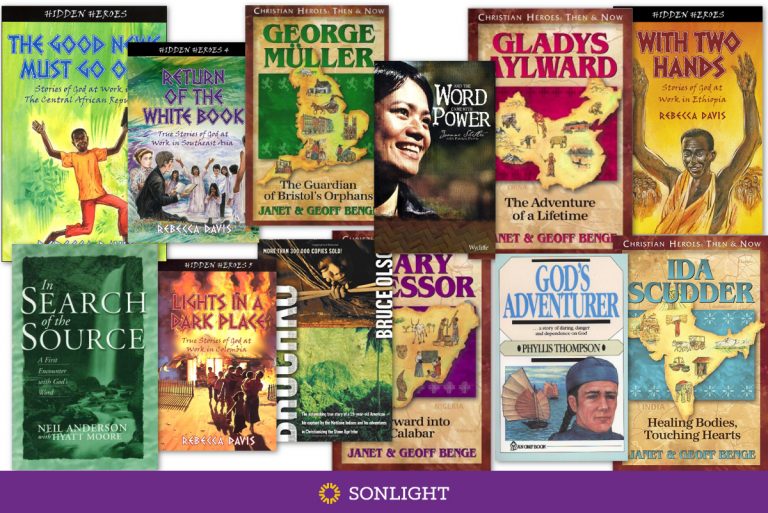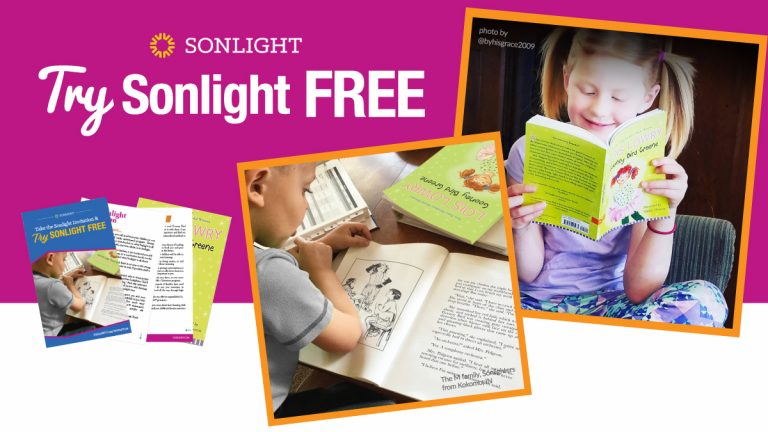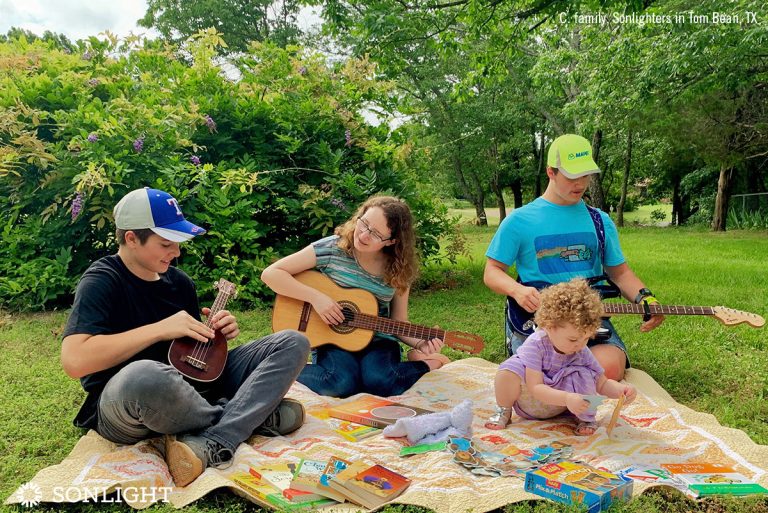
With God, all things are possible! Stories of God's faithfulness on the mission field and the sacrifice of His missionaries will do more to grow your children's faith in God than a dozen lectures! Use these enjoyable missionary stories as family Read-Alouds for maximum spiritual benefit.
Because Christian missions is at the core of Sonlight, every History / Bible / Literature curriculum package includes at least one missionary biography. If you don't use Sonlight (yet) or aren't a homeschooler at all, be sure to read these twelve books to your children and add them to your home library. The discussions they inspire give you a chance to impart your faith to your children in a natural way. You will be changed, too, by these inspiring accounts.
Let's travel every continent of the globe by way of the stories of these exemplary Christian missionaries!
1. God's Adventurer: Hudson Taylor
by Phyllis Thompson
from Sonlight's History / Bible / Literature F Package
Hudson Taylor was only 21 when he sailed from England. He had already learned he could trust God with the last coin in his pocket; he would need that faith as he set out to evangelize the Chinese.
This missionary biography is a thrilling true story of daring, danger, and dependence on God in China.
2. The Good News Must Go Out
by Rebecca Davis
from Sonlight's History / Bible / Literature A Package
Mama Laird served as a missionary in the Central African Republic for decades and saw great waves of people turning to God.
One dear follower was beaten by drunks until he almost died, but 300 or so people came to his house of death and followed Jesus. Finally one day, no one came. Then he said, "God, let me get up or die."
This is marvelous missionary story that will challenge your faith in the best of ways.
3. Return of the White Book
by Rebecca Davis
from Sonlight's History / Bible / Literature A Package
God prepared the way for the Karen people of Burma to come to know him.
When George Boardman and Adoniram Judson arrived, the Burmese were not terribly interested, but the Karen were desperately ready.
This missionary biography is an incredible story of God at work.
4. And the Word Came with Power
by Joanne Shetler
from Sonlight's History / Bible / Literature C Package
This missionary tale is the moving story of how God's word transformed an entire people--as well as the woman whom He had sent to translate the Scriptures for them.
This story of one woman's life of fervent prayer in the Philippines will inspire you and your children to greater faith.
5. Bruchko
by Bruce Olson
from Sonlight's History / Bible / Literature F Package
This missionary biography tells the true story of Bruce Olson who, at 19 years of age, leaves his home in Minnesota to reach the Motilone Indians, a murderous tribe in the jungles of Colombia.
Captured by the people with whom he wants to share the Gospel, Olson proves God's strength is made perfect in weakness.
This one is thought provoking and challenging!
6. George Muller
by Janet & Geoff Benge
from Sonlight's History / Bible / Literature B Package
One the greatest ways to boost our faith is by seeing how God has been faithful in the past. We may tell children that God answers prayer, but when they experience George Muller praying for bread for an entire orphanage, they can feel the weight of need. When they catch their breath as he gets news of a miraculously broken down bread cart just outside his door at breakfast time, they will never forget this truth.
In this gripping true story, you and your children will come face to face with Muller's massive faith and generosity. With scarcely enough money for his own family, George Muller sponsored a "Breakfast Club" for orphans that eventually filled five large houses and cared for 10,000 children.
7. Gladys Aylward
by Janet & Geoff Benge
from Sonlight's History / Bible / Literature C Package
This classic missionary biography recounts the work of Gladys Aylward, an uneducated British housemaid who went to China via Russia in the midst of the Soviet-Chinese war in the early 20th century.
Her bravery will inspire your children to do great things for God and trust him at all times. As a bonus, you get a glimpse of the customs and culture of China during that period.
8. With Two Hands
by Rebecca Davis
from Sonlight's History / Bible / Literature C Package
This missionary biography takes you to Ethiopia where you get eighteen glorious chapters of God at work:
- Witch doctors are transformed.
- The single person who could translate ends up in just the right place.
- Two girls pray daily for transformation for many years and finally transformation happens.
It's marvelous.
9. In Search of the Source
by Neil Anderson with Hyatt Moore
from Sonlight's History / Bible / Literature E Package
A translator struggles to help the Falopa people of Papua New Guinea understand what the Bible says in this missionary biography.
Fascinating, thought-provoking, and often funny, these are the stories of a culture's first encounter with God's Word. You will love reading it and will probably want to re-read it at least once!
10. Lights in a Dark Place
by Rebecca Davis
from Sonlight's History / Bible / Literature E Package
In this modern day missionary biography, you get fourteen stories of God at work in Colombia, South America.
It's dramatic and exciting: people escape a burning house, see dreams and visions, and try to convert kidnappers.
When you come to the end of this book, you and your children will say, "Wow! He is worthy of praise!"
11. Mary Slessor: Forward into Calabar
by Janet & Geoff Benge
from Sonlight's History / Bible / Literature F Package
As a cotton mill worker, Mary Slessor longs to be used by God in a mighty way. Her prayer is answered when she becomes a pioneer missionary in Africa.
In the Calabar region, she not only teaches people about Christ but also helps to put an end to twin-killings and other brutal practices.
This one is a thrilling biography, composed by master biographers.
12. Ida Scudder: Healing Bodies, Touching Hearts
by Janet & Geoff Benge
from Sonlight's History J Package
This missionary biography is an amazing story of a woman who grew up in India and couldn't wait to leave. In one night, three men came to ask her to help their laboring wives. All three refused her father's help (he was a doctor), preferring to let their wives die than break religious taboos. And all three did die.
Ida realized she could make a difference, and so she went to medical school to use her gifts for the Lord in India. She served in India for decades, helping the lepers, founding a teaching hospital, and serving the people.
Biographies of missionaries demonstrate clearly how God is active in the lives of His followers. These books will increase your faith and challenge you and your children to rest in God's provision.

To see more top-notch books and our complete book-based homeschool programs, ask for a complimentary copy of your catalog today.

























